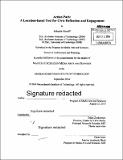| dc.contributor.advisor | Ethan Zuckerman. | en_US |
| dc.contributor.author | Graeff, Erhardt (Erhardt Charles) | en_US |
| dc.contributor.other | Massachusetts Institute of Technology. Department of Architecture. Program in Media Arts and Sciences. | en_US |
| dc.date.accessioned | 2015-02-25T17:13:21Z | |
| dc.date.available | 2015-02-25T17:13:21Z | |
| dc.date.copyright | 2014 | en_US |
| dc.date.issued | 2014 | en_US |
| dc.identifier.uri | http://hdl.handle.net/1721.1/95604 | |
| dc.description | Thesis: S.M., Massachusetts Institute of Technology, School of Architecture and Planning, Program in Media Arts and Sciences, 2014. | en_US |
| dc.description | Cataloged from PDF version of thesis. | en_US |
| dc.description | Includes bibliographical references (pages 77-80). | en_US |
| dc.description.abstract | Many platforms for civic engagement, whether online or offline, require that citizens leave the places they normally inhabit physically or virtually and commit to a separate space and set of processes. Examples include town hall meetings, occurring during specific times and in specific places, and online forums, where deliberation occurs within profile-based websites for which you need to sign up and to regularly return. This thesis responds to the design challenge and research question: How do you address barriers to minimum effective engagement in community projects, and ensure that all citizens can contribute their input on how to improve their local communities? In order to raise levels of participation in community projects and expand the range of voices heard in governmental decision-making, there is a need for a civic engagement platform that is lightweight and compelling enough to enjoy continued use. To this end, I have developed a theoretical basis for effective citizenship through monitorial actions aided by mobile computing, finding connections between various theories of citizenship and learning to fill a gap in the literature and in terms of civic technology design. My argument and design goals for such a system are reinforced by findings from a needs assessment of Boston-area municipalities that confirmed a desire to use new technologies to elicit feedback on community issues from a more diverse demographic than those who currently attend public meetings. Based my analysis of the literature and the distilled design goals, I built and completed early-stage user testing of a prototype smartphone app-based civic engagement platform called Action Path, which uses location-awareness in the form of geo-fences along with push notifications to prompt users to respond to one-item surveys dotting their urban landscape. Interviews with users suggest Action Path might help people see their communities as filled with opportunities for civic intervention, and might increase their sense of efficacy. Additionally, workshops about geo-fence design and curricular design with potential stakeholders showed how Action Path might be effectively deployed through civic technologists and in schools. | en_US |
| dc.description.statementofresponsibility | by Erhardt Graeff. | en_US |
| dc.format.extent | 88 pages | en_US |
| dc.language.iso | eng | en_US |
| dc.publisher | Massachusetts Institute of Technology | en_US |
| dc.rights | M.I.T. theses are protected by copyright. They may be viewed from this source for any purpose, but reproduction or distribution in any format is prohibited without written permission. See provided URL for inquiries about permission. | en_US |
| dc.rights.uri | http://dspace.mit.edu/handle/1721.1/7582 | en_US |
| dc.subject | Architecture. Program in Media Arts and Sciences. | en_US |
| dc.title | Action path : a location-based tool for civic reflection and engagement | en_US |
| dc.title.alternative | Location-based tool for civic reflection and engagement | en_US |
| dc.type | Thesis | en_US |
| dc.description.degree | S.M. | en_US |
| dc.contributor.department | Program in Media Arts and Sciences (Massachusetts Institute of Technology) | |
| dc.identifier.oclc | 903900516 | en_US |
